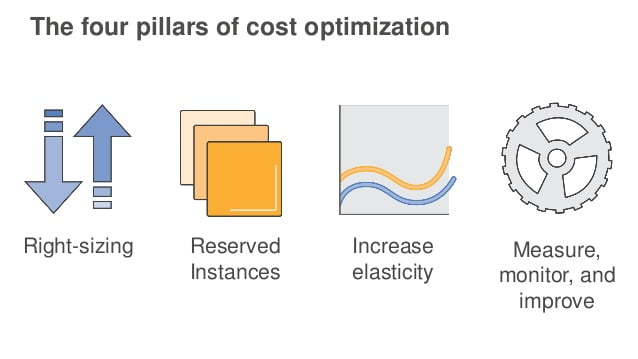Amazon Web Services (AWS), the cloud platform offered by Amazon.com Inc, is one of the giant components of the e-commerce giant’s business portfolio. In 2021, AWS made a record $14.8 billion in net sales. With more than 30% growth in the last few quarters, AWS has become one of the most sought-after cloud computing platforms globally. In this blog, we shall talk about why AWS cost optimization should be a part of your cloud strategy.
AWS cost optimization best practices are a never-ending process. For example, your AWS Cloud needs to be monitored to identify when assets are being underutilized (or not utilized). Establishing a Cloud Financial Management practice can help establish a standardized process. Additionally, Cloud Financial Management (CFM), FinOps, or Cloud Cost Management helps align and develop financial goals and gain greater business efficiencies.
What are the best practices for AWS cost optimization?

1. Rightsizing EC2 instances:
Rightsizing is to match instance sizes to their workloads. Unfortunately, it doesn’t quite work because of how models double incapacity for each increase in size.
2. Scheduling on/off times:
Scheduling on/off times for non-production instances, like those for developing, staging, testing, and QA, helps you save around 65% of running these instances if you apply an “on” schedule of, i.e., 8.00 a.m. to 8.00 p.m. Monday to Friday.
3. Delete unattached EBS volumes:
Depending on how long your business operates in the cloud, there can be thousands of single EBS volumes in your AWS Cloud. It’s one of our AWS cost optimization best practices, even if your business is relatively new to the AWS Cloud.

How digital transformation can grow your business?
4. Delete Obsolete Snapshots:
Snapshots are generally a great way to back up your data. Usually, you need the most recent snapshot to restore data if something goes wrong.
5. Release unattached Elastic IP addresses:
Businesses are allowed a maximum of five Elastic IP addresses since Amazon doesn’t have an unlimited pool of IP addresses.
Exceptions to the free of charge rule occur if you remap an IP address more than 100 times a month or hang on to single Elastic IP addresses once you have terminated the instances to which they were attached. For example, the charge for single Elastic IP addresses may only be $0.01 per hour, but if fifty AWS accounts each hold back two IP addresses, that amounts to $8,760 of waste per year.
6. Upgrade instances to the latest generation:
When AWS releases a generation of instances, they tend to have improved performance and functionality compared to their predecessors. This means you can either upgrade existing cases to the latest generation or downsize existing instances with borderline utilization metrics to benefit from the same level of performance at a lower cost.
7. Buy reserved nodes for Redshift and Elasticache services:
Earlier, businesses used to purchase advanced-payment “Heavy Utilization” discounts, but these have changed to mirror Reserved Instance purchases for EC2 and RDS instances. Reserved Nodes can be purchased for Redshift, ElasticCache, Redis, and Memcached Services for 1-year or 3-year terms, with the option of paying the full amount upfront or partially upfront or paying monthly.
8. Terminate zombie assets:
The term “zombie assets” is used to describe any unused asset contributing to the cost of operating in the AWS Cloud. Other assets that fall into this category include components of instances activated when an instance failed to launch and unused Elastic Load Balancers.
A challenge businesses often encounter when implementing the best practices is that some unused assets are difficult to find. However, in this blog, we recommend some of the most accepted practices for AWS cost optimization.
9. Move infrequently-accessed data to lower-cost tiers:
AWS offers six tiers of storage. Determining which tier is most suitable for data depends on the frequency of data accession and the speed a business needs to recover its data. The monthly cost would vary from a standard $0.023 per GB (US East Region) to $0.00099 per GB.
10. Increase elasticity using AWS auto-scaling:
Increasing flexibility to your application and using these resources when you need them while turning them off when not using them. For example, you could use AWS Auto Scaling to schedule workloads when needed. Furthermore, AWS provides a solution called AWS Instance Scheduler, which creates a custom start and stop plans for your Amazon EC2 and RDS instances.
11. Reduce cost by using AWS SSL Certificates:
Most organizations use SSL certificates of the third party SSL that might cost $56 and above and AWS charges $600 per month. In addition, you can reduce $600 by using AWS SSL certificates without additional costs.
In all, there are certain problems that can arise when a firm tries to implement changes in its cost optimization strategy. Many businesses end up under-provisioning resources, impacting their security aspects, or failing to take full advantage of the appropriate AWS infrastructure. For more information or consultation sessions, please get in touch with our experts here.



